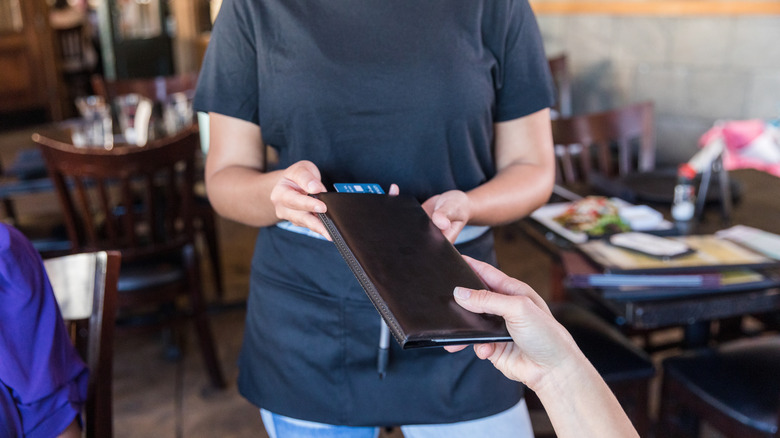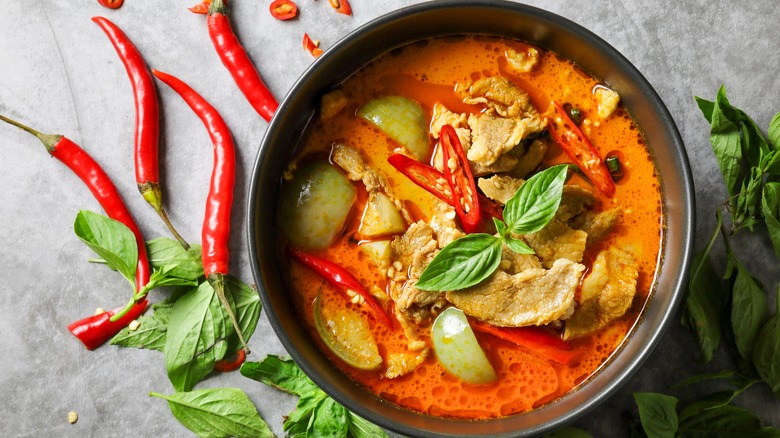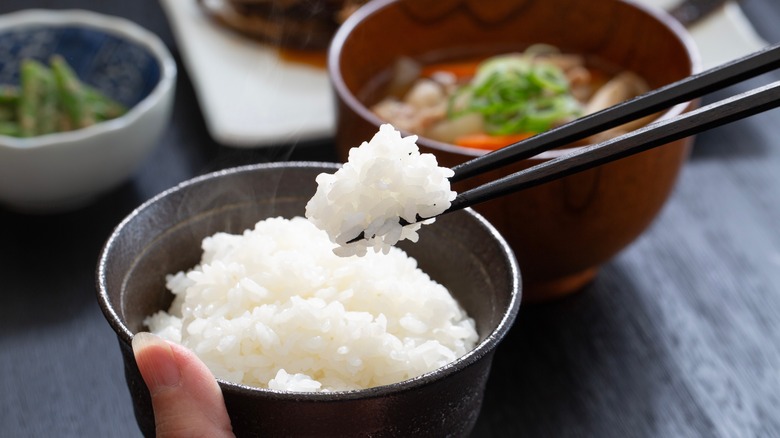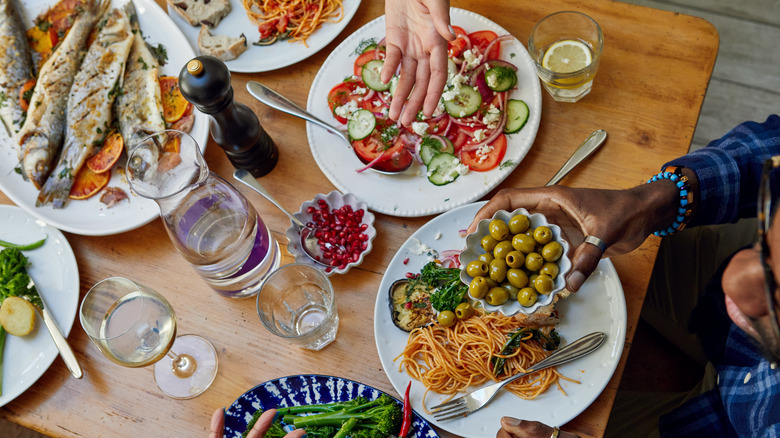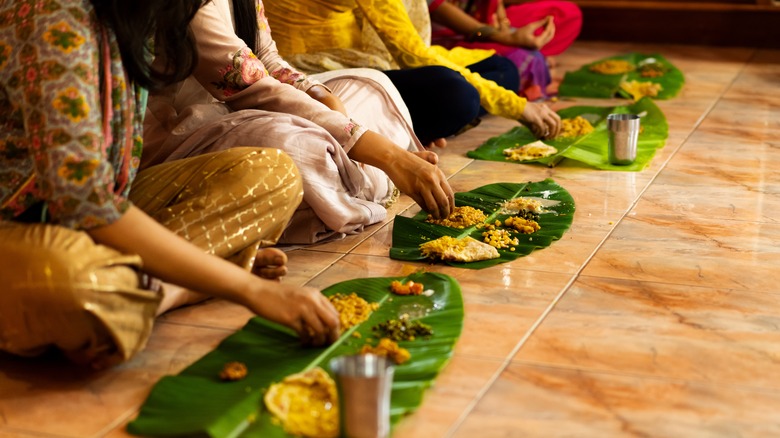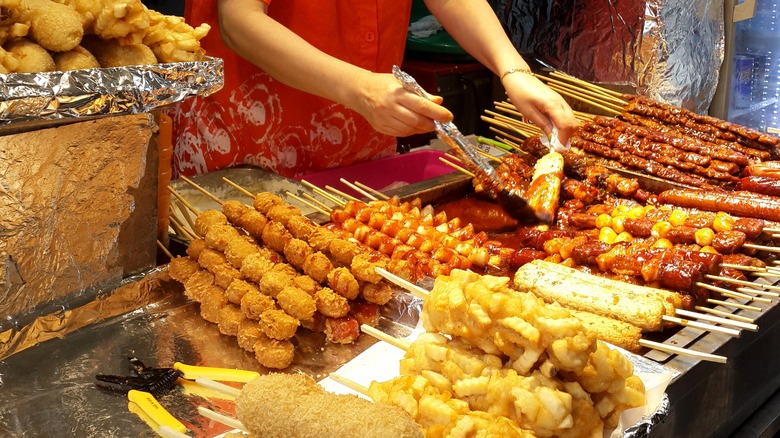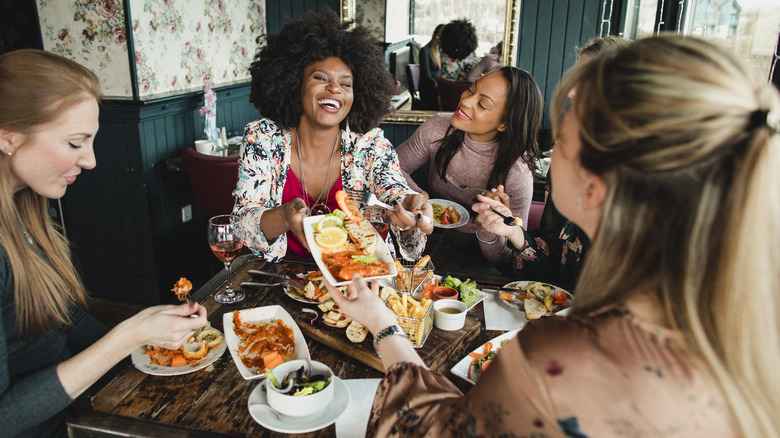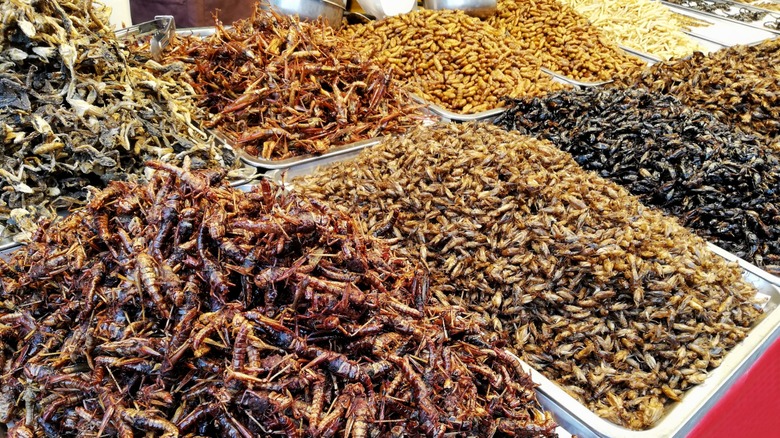14 Dining Faux Pas To Avoid While Traveling
You may think you know all there is to know about American dining customs, and maybe you're right. They do things a lot differently in other countries, though. While your American dining etiquette knowledge will take you pretty far when traveling internationally, there's still a lot to learn. In fact, it's pretty easy to make an array of dining faux pas without even realizing it. We're not talking about archaic restaurant rules that many people think are outdated, either.
Due to varying cultures and customs, the specifics of dining etiquette vary greatly from one country to the next. From whether or not it's rude to slurp noodles, to pouring drinks incorrectly, to being unaware of tipping protocols and beyond, there's a long list of silly mishaps you'd be wise to avoid. It's not like anything bad would happen if you do the wrong thing, but wouldn't it be better if we ventured into the world as well-informed tourists?
It's always best to brush up on specific dining etiquette and customs for any country you plan on visiting. However, knowing the upcoming major faux pas will surely get you miles ahead of the average, unaware (some might say rude) tourist. If you want to avoid any side-eye or downright looks of disapproval when dining in other countries — which, of course, you do — keep reading so you can cross a number of glaring faux pas off your list of potential mistakes.
Not understanding tipping protocols
In the United States, tipping 18% to 20% is customary. Some people will tell you 15% is still okay, but really, that was the norm in the 1980s, so an increase is more than deserved. Regardless, America is one of the countries with the largest tipping expectations. When traveling internationally, the tipping protocols vary greatly. In most countries, there's no need to tip so much, and in some cases, it can even be insulting to do so. For example, in Japan, any type of tip is considered rude.
In many countries, gratuity is included in the bill. When it isn't, only a 10% tip is customary. In Australia, 10% is only expected in fine dining establishments. In China, just 3% is the norm, and only in major cities. In Singapore, Thailand, Denmark, and more, you don't have to tip at all — and these are just a small handful of examples. So, before you frivolously add a large gratuity to your total, it's always best to research the specific country you are in. Not only will it save you money on travel expenses, but it ensures you don't accidentally insult anyone.
Underestimating how spicy dishes might be
If you've ever had authentic Thai or Mexican food, you are probably familiar with just how spicy some of it can be. We mean truly authentic, though, like in the origin country. Here in the United States, you can find the same regional cuisines being served all over the place, but they are often made with much less of a kick in order to appeal to American preferences. With this in mind, it'd be a big mistake to underestimate the spiciness of many international cuisines.
As noted, Mexico and Thailand are countries where you'll want to tread lightly if you can't handle a ton of heat. However, the list of countries that revel in extra spicy foods doesn't stop there. If your tolerance for heat is minimal, you should also be careful in India, South Korea, China, Malaysia, Indonesia, Ethiopia, Jamaica, and Turkey, just to name a few. Even if you fancy yourself as someone who enjoys spicy foods you should expect a serious increase in spiciness when visiting these countries. Otherwise, you may find yourself choking down something that leaves you running for the bathroom later on. That is of course, if you can even work your way through it in the first place.
Using your chopsticks the wrong way
Whether you are a pro at using chopsticks or not, there are a few faux pas to avoid when using them abroad. They are quite easy to commit if you're unaware, too. The first is assuming every country in Asia uses chopsticks. Several countries, like Thailand, do not. Another is removing disposable chopsticks from the wrapper and rubbing them together to remove splinters. In Japan, this suggests they are low quality, and your host could take offense.
In addition to specific regional faux pas, there are a handful of chopstick etiquette rules that will serve you well no matter what you happen to be. For starters, you never want to stick your chopsticks into a bowl so they are standing up vertically because it is associated with death, and therefore unlucky. Resting them on the table is also impolite. Instead, you want to rest them across the edge of your plate or bowl. If you are going to use chopsticks, you also need to fully commit. No skewering foods, use them correctly. Of course, you should never play with them, either. Would you use a fork and knife as a set of drumsticks to fiddle with at the table? Not if you're trying to be polite. Treat chopsticks like a utensil, not a toy.
Not ordering the right amount of food
This will come as no surprise to many of us, but food portions tend to be much larger in the United States than abroad. Yup, just like in Texas, everything is bigger here — even the amount of food you get with each plate. When dining internationally, you should always keep this in the back of your mind. Some examples of this include Japan, where portion sizes are much smaller because wasting food is frowned upon. Or, Mexico, where many dishes are significantly smaller than you'd get at home. For example, a quesadilla is often made with a large, 10-inch tortilla here in the States but in Mexico, a much smaller 5-inch tortilla is typically used.
This doesn't mean you need to order twice as much food, but it does mean you shouldn't expect massive portions like we often get here in the States. Ordering too much and being wasteful is also a big no-no in many countries. If you have any leftovers, you better be prepared to take them with you. If you're staying in a hotel, this might not be ideal, so order accordingly. When unsure, start slow. You can always order more, and placing a second order is typically much better than wasting food at the end.
Eating with the wrong hand
In quite a few places, like India, Ethiopia, Morocco, and the Middle East, people often eat with their hands. However, there are still certain etiquette rules to follow. It's not a free for all. The first, which is probably pretty obvious, is that you should always wash your hands before digging in. Using clumps of rice or small pieces of bread as a utensil is also common. You don't want to simply scoop up food with your fingers. Putting your fingers in your mouth is also a faux pas, especially when sharing, which is customary in many countries where people eat with their hands.
Another serious no-no is using your left hand to pick up and enjoy food. This may seem trivial if you aren't familiar with the practice, but it actually dates back quite far. Historically, the right hand is for eating because the left hand is used for less clean activities — like using the bathroom and all that comes with it. In fact, this practice is part of Islam and it is mandated in the teaching of the prophet Muhammad. So, yeah, it dates back pretty far.
Overlooking street food
There are a lot of rumors swirling around about whether or not street food is safe to eat in other countries. Some of them are probably even true, but discounting street food as a whole is not a smart move. Many countries pride themselves on their outstanding street food and in some cases, it's the best way to truly experience a country's culinary offerings. Plus, the thrill of walking through a crowded market with delicious aromas wafting through the air is an experience all in itself.
Some of the best countries to get street food include Thailand, Mexico, Singapore (it's got some seriously drool-worthy stuff), and Vietnam. In each of these countries, you get a wide array of foods that are sure to pique anyone's interest. Hong Kong and many other parts of Southeast Asia are also known for having amazing street food. To get a taste of authentic cuisine, try new foods, and interact with locals directly, there's often no better way than exploring a country's street food options.
Ignoring customs about how to pour drinks
From how and who makes toasts to who should pour, there are many customs surrounding drinking. It isn't always like here in the United States, where you can pour water, wine, or any other beverage freely without anyone thinking twice about it. Sure, in some places, these details don't matter, but they can make a big difference in places like Japan, France, Korea, and Egypt to name just a few.
In France, you should always wait for everyone in your group to be served before taking your first sip of wine. It's also customary to make eye contact when you toast. In both Japan and Egypt it is considered impolite to pour your own drinks, someone else at the table should do it for you. In Korea, women shouldn't pour drinks for other women. As you can see, there's a lot more that goes into drinking etiquette than you might expect and these examples only scratch the surface. As a general rule of thumb, you should always look into drinking customs before visiting any location so you can avoid accidental faux pas.
Expecting meal times to be the same
Americans typically enjoy dinner between 6 p.m. and 7 p.m., but this isn't always the case when you are traveling abroad. Depending on where you are, dinner time could be somewhat earlier, or in some cases, much later. So, when you are wandering around looking for dinner at 6 p.m. or 7 p.m. and see that many restaurants are not yet open or seem fairly empty, it isn't necessarily an indicator of a place being unpopular. It might just be that the locals eat at different times.
Spain is a great example of how dinner times vary across the globe. Traditionally, dinner time does not start there until 9 p.m. and it extends to about 11 p.m. which is obviously much later than in other countries. South Africa has a similar timeline for dinner, just not quite as late. They tend to eat dinner between 8 p.m. and 10 p.m. Adversely, Norwegians often enjoy dinner between 4 p.m. and 5 p.m. — and the list for varying dinner times goes on. All things considered, it's best to just go with the flow regarding mealtimes in other countries, especially if you want to fully immerse yourself in the local culture and customs.
Not sharing dishes
In many countries, communal dining is an important part of the local culture. Just think about how Italians love to eat large family-style meals where everyone is sharing everything and having a wonderful time. You can picture it, right? Well, they are not the only ones who do it this way and if you opt not to share in some countries, it may even be considered a dining faux pas. At the very least, it will hinder your chances of getting an authentic local experience.
Ethiopia, Korea, and Thailand are also countries where communal dining is the norm. Like in Italy, it fosters a sense of community and respect amongst diners. Plus, it allows you to get a taste of a variety of delicious dishes, something you wouldn't be able to do if everyone ordered for themselves. Don't do yourself a disservice by refusing to share plates in these kinds of scenarios. If you do, you'll not only be missing out on trying an assortment of foods, but you may even run the risk of being impolite.
Assuming it's rude to slurp noodles
In most countries, slurping or making loud noises while you are eating is considered rude, but that isn't always the case when it comes to enjoying noodles. You may have heard that it's polite to slurp your noodles in Asia, but this is only halfway true. In fact, just like here in the United States, slurping your noodles is frowned upon in countries like South Korea and Singapore.
So, where is slurping your noodles not only acceptable? Japan and China. Actually, in these countries slurping noodles is not only acceptable, but it is considered proper etiquette, and it's best to do it loudly. When you slurp it helps cool down hot noodles, and many people also believe it enhances their flavors and textures, too. Plus, in Japan and China, it is an audible way to send your compliments to the chef. Of course, it can also be kind of fun, so feel free to slurp away in Japan and China. It won't be considered rude and of course, make sure not to give anyone else any disapproving looks if you hear them slurping away.
Being rude when you encounter unfamiliar foods
Okay, not all new foods you encounter in foreign countries are going to instantly pique your interest. In fact, some might be an instant turn off and that's okay, as long as you keep it to yourself. The last thing you want to do is offend someone or be rude by exclaiming that something they eat is yucky, gross, or weird. As the saying goes, if you don't have anything nice to say, don't say anything at all.
At this point, you are probably wondering what kinds of foods could make you want to shy away, and if you are not typically an adventurous eater, the list might be longer than you'd think. For example, in Thailand, India, and Vietnam people eat rats. Indonesia also embraces many exotic meats like snakes, bats, lizards, rats, and more. In Peru, eating guinea pigs is very common, kangaroo is enjoyed in Australia, and pigs' feet are pickled and brined in Mexico. Fried insects are also seen as a tasty snack in countries like Thailand, Brazil, and Ghana. If you ever come across any of these foods, either give them a try or play it safe and don't comment.
Being afraid to try new things
One of the best things about traveling is that it exposes you to new and exciting things. Everything from the scenery to the culture to the food is different (at least in many places), and it's best to lean into the unfamiliarity. If not, what's the point of traveling anyway? In particular, being afraid to try new foods is a regrettable faux pas when traveling internationally. After all, you are already in a new place, so you don't really have a choice about experiencing the new scenery and people, but no one will force you to try new foods — that's up to you.
For some of us, it's easy to stick with what we know regarding food, and that might be just fine when you are at home, but it's best to branch out when you are traveling. Who knows what kind of lesser-known gems you might experience? You might even find a new favorite food, but this can only happen if you are willing to try new things. From uncommon fruits to Polish pierogies to a vast array of regional specialties, there's a whole world of amazing dishes to try. Don't sell yourself short.
Expecting foods to taste just like they do at home
Regional variations of dishes are to be expected, even within the same country. If you compare Northern Italian cuisine to Southern Italian, you get lots of differences, like whether they use béchamel or ricotta for lasagna. However, when you factor in traveling abroad, and try to compare American lasagna to Italian, the difference becomes even more apparent. The same can be said of all kinds of dishes and cuisines, like pizza, Thai, Mexican, and more. With this in mind, expecting your food to be the same as the stuff you get at home won't serve you well.
In many cases, the food you are served abroad could taste better, but either way, differences are extremely likely. As a general rule of thumb, you shouldn't assume familiarity with international cuisine. Will it be similar? Most likely, but not quite the same and that's okay. If you lean into the variations, not only will you prevent any potential letdown, but you might find a new, exciting way to make a classic favorite.
Not doing any research on dining etiquette before you dine out internationally
While the international dining faux pas we have discussed so far will take you far when traveling abroad, in reality, they only scratch the surface. It's a big world out there, so abundant cultural differences are to be expected. The best way to set yourself up for success and avoid any unintentional faux pas is to do a bit of research on whatever country you are traveling to. That way, you can rest assured you know common etiquette rules and do your best to avoid them.
In addition to doing some research on your own, paying attention to social cues in any setting is a great way to pick up on small nuances you either didn't encounter in your research or simply forgot along the way. Let the locals guide you, and if someone tells you something is impolite or out of the ordinary in any way, listen to them. Most locals want you to enjoy yourself, they won't steer you wrong.


